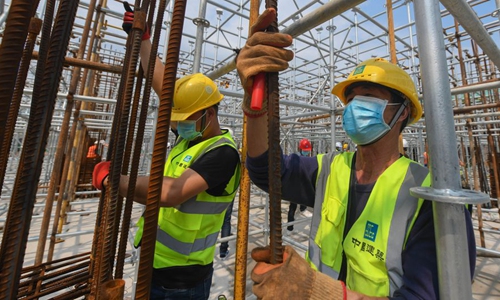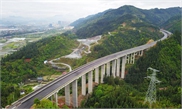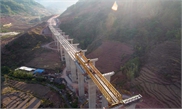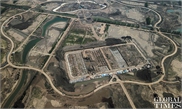
Staff members work at a construction site in Wuhan, central China's Hubei Province, March 26, 2020. (Xinhua/Cheng Min)
The Chinese cement industry is being restarted buoyed by an accelerated recovery in the construction sector as the coronavirus subsides in China. With a positive outlook this year, analysts said cement could lead the rebound across multiple industries.
Driven by multiple infrastructure projects, some cement factories are running at full capacity to meet surging demand since the end of March with more staff returning to their posts to resume construction.
Due to the epidemic's impact, China's cement output slid by 23.9 percent year-on-year in the first quarter tallying 299.07 million tons, data from the National Bureau of Statistics showed on Friday. In March, the decrease was 18.3 percent on a yearly basis.
East China's Zhejiang Province is at the forefront of the demand for cement while other provinces like Shandong, Jiangsu and Anhui provinces are recovering, Hou Linlin, an analyst at industry website sci99.com, told the Global Times on Sunday. Hou said that demand in some northern provinces remains sluggish.
"Cement shipments could be referred to as a real-time tracker of the vitality of infrastructure construction as well as real estate construction, as the two are closely related," Hou said.
Data from the Ministry of Housing and Urban-Rural Development of China showed that 158,700 housing and municipal infrastructure projects have restarted operation across the country as of April 1 with a resumption rate of 85.06 percent.
Zhejiang has taken the lead step in infrastructure, with 537 major projects underway at the start of 2020, worth 886.4 billion yuan ($125.4 billion) in total.
Most of the major projects to resume construction in Zhejiang are connected to the technology sector, 61 percent of total projects compared with 41 percent in 2019.
Construction started on the Alibaba Damo Academy in Hangzhou, capital of Zhejiang, in March. With an investment of 20 billion yuan, the academy is expected to become an incubator of strategic innovation industries such as big data, artificial intelligence, driverless cars and quantum computing.
According to industry website cementren.com, there are projects worth nearly 8 trillion yuan under gradual operation, which will drive demand for cement as well as an expected price increase.
Compared with infrastructure projects, there is more uncertainty hanging over the real estate sector, as there are few new projects now, causing concern in the cement sector in terms of demand, said Hou.
"The period from September to year-end is traditionally more vibrant than the first part of the year, so we can expect more demand later," Hou said. The outlook is promising for the sector, Hou said, although it is unlikely that cement prices will recover to the record highs seen at the end of 2019.
China's cement sector reported a surge in revenue and profits in 2019. Total revenue reached a historic high of 1.01 trillion yuan, up 12.5 percent year-on-year, according to the Ministry of Industry and Information Technology (MIIT).
The sector's combined profits surged 19.6 percent year-on-year to hit 186.7 billion yuan, also a historic high, which can be attributed to sector's continued progress in cutting overcapacity through deepening supply-side structural reform, said the MIIT.
The high profits seen by cement firms last year are reflected in their financial earnings reports, which are being released this month.
The Shanghai-listed Gansu Qilianshan Cement Group Co recorded an 88.48-percent year-on-year profit rally in 2019. Shenzhen-listed Guangdong Tapai Group Co raised workers' salaries last year to 219,000 yuan on average per person up from 154,000 yuan in 2018, according to financial data provider Wind.




